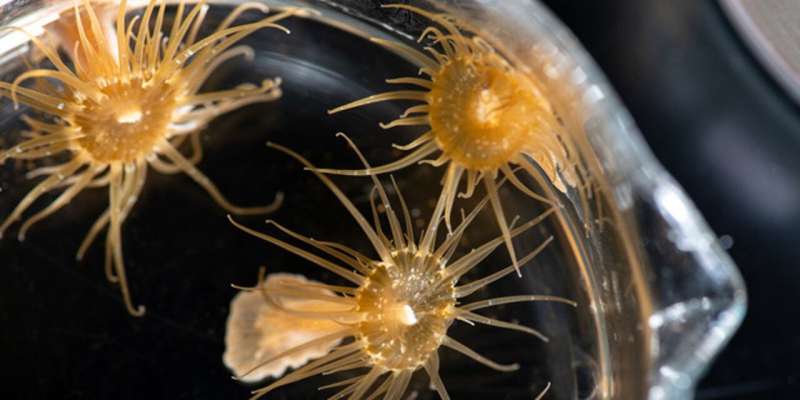This article has been reviewed according to Science X's editorial process and policies. Editors have highlighted the following attributes while ensuring the content's credibility:
fact-checked
peer-reviewed publication
trusted source
proofread
Study shows how corals and anemones engage in symbiotic relationships with algae and swap nutrients with them

"Eat or be eaten" is not always the way things are in nature. It can be beneficial for different species to team up and pool their capabilities. Cnidarians such as corals and anemones were already committing to this kind of biological joint venture with algae from the dinoflagellate group 250 million years ago.
Thanks to these symbioses, both sides are able to flourish in nutrient-poor waters where, in isolation, neither would stand a chance of surviving. Corals can thus lay the structural foundation for the most biodiverse of all marine ecosystems. They protect their dinoflagellate symbionts from predators and supply them with inorganic nutrients such as nitrogen and phosphorus. Conversely, the algae provide the coral with the products of their photosynthesis: carbohydrates, protein and fat.
Yet this happy marriage can only work if the 'barter' arrangement is precisely regulated. And although a successful exchange of nutrients is critical to the health of the corals and, hence, to the whole of the coral reef ecosystem, the molecular mechanisms that regulate communication within this partnership are still largely unknown. A new study in Current Biology now shows that a signal path from way back in the evolutionary process plays a crucial role in the 'trade' that takes place between algae and coral.
Eaten but not digested
"Most types of coral have to absorb new dinoflagellate symbionts from their environment in each new generation," explains LMU biologist Professor Annika Guse, lead author of the new study. The symbionts are initially absorbed like food into the coral's digestive cavity and from there into the host's cells. During this process, a kind of bubble known as the symbiosome forms around the algae.
The symbiosome is chemically similar to a lysosome—another cell organelle that plays a pivotal role in digestion. "The difference to the lysosome is that, in the symbiosome, the dinoflagellates remain intact," Guse notes. In effect, the host eats its symbionts without digesting them. "We do not yet know exactly how the algae survive this process."
Inside the symbiosome, the algae then continue to photosynthesize and produce nutrients that they share with their host. All nutrients and communication processes between the partners must therefore penetrate the shell of the symbiosome, which is made up of membranes from both host and symbiont.
A 'cell tax' between symbiont and host
To do all this, the symbiotic partners evidently use a signal path known as the mechanistic target of rapamycin (mTOR), which regulates cellular metabolism in all eukaryotes as a function of environmental factors such as the availability of nutrients. It has already been proven for other species that mTOR is also used for nutritional symbioses: "Various insect hosts use mTOR signal transmission for their bacterial endosymbionts," Guse says. "Evidence of the same path has also been found for legumes and their fungal partners."
The researchers therefore suspected that mTOR could also be involved in the partnership between cnidarians and dinoflagellates. "We have been able to prove that endosymbiontic corals use the mTOR signal path to incorporate nutrients from the symbionts in the host metabolism." All the vital components of mTOR exist in both anemones and corals.
Annika Guse and her colleagues investigated the extent to which this signal path is activated by the presence of algae partners from the Symbiodiniaceae family at different developmental stages in anemones of the genus Aiptasia. They also tested how inhibiting mTOR signal transmission affected the symbiotic function.
"Our findings show that mTOR signal transmission is activated by the symbiosis, and that disruptions to the signal path impair symbiosis at both the cellular and the organismic level," Guse explains. "With the aid of a specific antibody, we were also able to show that mTOR is localized on the membranes of the symbiosome."
Repurposing an age-old signal path
Studying their findings, the biologists conclude that mTOR is of tremendous importance to the incorporation of nutrients in the host's metabolism and to the stability of the symbiosis. Given that much of the energy consumed by symbiotic cnidarians comes from their symbiotic partners, it is plausible that the highly conserved mTOR signal path has ultimately been used for efficient nutrient sensing within the framework of symbiosis.
Accordingly, Guse and her team propose a model in which the nutrients released by the algae activate mTOR signal transmission in the symbiosome and in the host tissue—similar to the sensing of nutrients from external sources.
The activation of mTOR signal transmission was probably also an important step in the evolution of this symbiosis, allowing the algae to survive within the host cells. "The mTOR activity controls what is called autophagy, a very ancient immune reaction on the evolutionary scale that is triggered when pathogens penetrate the host and that leads to the destruction of the intruder," the biologist explains.
This, she believes, is the reason why some pathogens—and the bacterial endosymbionts of some insects, too—have developed mechanisms to bypass autophagic elimination. Early symbionts could have been ingested by a cnidarian and absorbed into its cells. Instead of being ejected or destroyed, however, they were retained as they supplied the host cell with nutrients, activating the mTOR signals and thereby stopping the process of autophagy.
"We are only now beginning to understand how the complex interaction between host and algae works and was able to develop over a million years of co-evolution," Guse says.
More information: Philipp A. Voss et al, Host nutrient sensing is mediated by mTOR signaling in cnidarian-dinoflagellate symbiosis, Current Biology (2023). DOI: 10.1016/j.cub.2023.07.038
Journal information: Current Biology
Provided by Ludwig Maximilian University of Munich



















